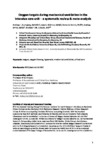Oxygen Targets During Mechanical Ventilation in the ICU: A Systematic Review and Meta-Analysis
| dc.contributor.author | Cumpstey, AF | |
| dc.contributor.author | Oldman, AH | |
| dc.contributor.author | Martin, DS | |
| dc.contributor.author | Smith, A | |
| dc.contributor.author | Grocott, MPW | |
| dc.date.accessioned | 2022-03-29T13:28:00Z | |
| dc.date.available | 2022-03-29T13:28:00Z | |
| dc.date.issued | 2022-04 | |
| dc.identifier.issn | 2639-8028 | |
| dc.identifier.issn | 2639-8028 | |
| dc.identifier.uri | http://hdl.handle.net/10026.1/18979 | |
| dc.description.abstract |
<jats:sec> <jats:title>OBJECTIVES:</jats:title> <jats:p>Patients admitted to intensive care often require treatment with invasive mechanical ventilation and high concentrations of oxygen. Mechanical ventilation can cause acute lung injury that may be exacerbated by oxygen therapy. Uncertainty remains about which oxygen therapy targets result in the best clinical outcomes for these patients. This review aims to determine whether higher or lower oxygenation targets are beneficial for mechanically ventilated adult patients.</jats:p> </jats:sec> <jats:sec> <jats:title>DATA SOURCES:</jats:title> <jats:p>Excerpta Medica dataBASE, Medical Literature Analysis and Retrieval System Online, and Cochrane medical databases were searched from inception through to February 28, 2021.</jats:p> </jats:sec> <jats:sec> <jats:title>STUDY SELECTION:</jats:title> <jats:p>Randomized controlled trials comparing higher and lower oxygen targets in adult patients receiving invasive mechanical ventilation via an endotracheal tube or tracheostomy in an intensive care setting.</jats:p> </jats:sec> <jats:sec> <jats:title>DATA EXTRACTION:</jats:title> <jats:p>Study setting, participant type, participant numbers, and intervention targets were captured. Outcome measures included “mortality at longest follow-up” (primary), mechanical ventilator duration and free days, vasopressor-free days, patients on renal replacement therapy, renal replacement free days, cost benefit, and quality of life scores. Evidence certainty and risk of bias were evaluated using Grading of Recommendations Assessment, Development and Evaluation and the Cochrane Risk of Bias tool. A random-effects models was used. Post hoc subgroup analysis looked separately at studies comparing hypoxemia versus normoxemia and normoxemia versus hyperoxemia.</jats:p> </jats:sec> <jats:sec> <jats:title>DATA SYNTHESIS:</jats:title> <jats:p>Data from eight trials (4,415 participants) were analyzed. Comparing higher and lower oxygen targets, there was no difference in mortality (odds ratio, 0.95; 95% CI, 0.74–1.22), but heterogeneous and overlapping target ranges limit the validity and clinical relevance of this finding. Data from seven studies (<jats:italic toggle="yes">n</jats:italic> = 4,245) demonstrated targeting normoxemia compared with hyperoxemia may reduce mortality at longest follow-up (0.73 [0.57–0.95]) but this estimate had very low certainty. There was no difference in mortality between targeting relative hypoxemia or normoxemia (1.20 [0.83–1.73]).</jats:p> </jats:sec> <jats:sec> <jats:title>CONCLUSIONS:</jats:title> <jats:p>This systematic review and meta-analysis identified possible increased mortality with liberal oxygen targeting strategies and no difference in morbidity between high or low oxygen targets in mechanically ventilated adults. Findings were limited by substantial heterogeneity in study methodology and further research is urgently required to define optimal oxygen therapy targets.</jats:p> </jats:sec> | |
| dc.format.extent | e0652-e0652 | |
| dc.format.medium | Electronic-eCollection | |
| dc.language | en | |
| dc.language.iso | en | |
| dc.publisher | Ovid Technologies (Wolters Kluwer Health) | |
| dc.subject | critical care | |
| dc.subject | hyperoxia | |
| dc.subject | mechanical ventilation | |
| dc.subject | oxygen | |
| dc.subject | oxygen therapy | |
| dc.title | Oxygen Targets During Mechanical Ventilation in the ICU: A Systematic Review and Meta-Analysis | |
| dc.type | journal-article | |
| dc.type | Journal Article | |
| dc.type | Review | |
| plymouth.author-url | https://www.ncbi.nlm.nih.gov/pubmed/35506014 | |
| plymouth.issue | 4 | |
| plymouth.volume | 4 | |
| plymouth.publication-status | Published online | |
| plymouth.journal | Critical Care Explorations | |
| dc.identifier.doi | 10.1097/cce.0000000000000652 | |
| plymouth.organisational-group | /Plymouth | |
| plymouth.organisational-group | /Plymouth/Faculty of Health | |
| plymouth.organisational-group | /Plymouth/Faculty of Health/Peninsula Medical School | |
| plymouth.organisational-group | /Plymouth/REF 2021 Researchers by UoA | |
| plymouth.organisational-group | /Plymouth/REF 2021 Researchers by UoA/UoA01 Clinical Medicine | |
| plymouth.organisational-group | /Plymouth/Users by role | |
| plymouth.organisational-group | /Plymouth/Users by role/Academics | |
| dc.publisher.place | United States | |
| dc.identifier.eissn | 2639-8028 | |
| dc.rights.embargoperiod | Not known | |
| rioxxterms.versionofrecord | 10.1097/cce.0000000000000652 | |
| rioxxterms.licenseref.uri | http://www.rioxx.net/licenses/all-rights-reserved | |
| rioxxterms.type | Journal Article/Review |


